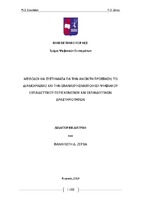Μέθοδοι και συστήματα για την ανοικτή πρόσβαση, το διαμοιρασμό και την επαναχρησιμοποίηση ψηφιακού εκπαιδευτικού περιεχομένου και εκπαιδευτικών δραστηριοτήτων
Methods and systems for supporting open access and reuse to educational resources and practices

View/
Subject
Web-based instruction -- Design ; Education -- Computer network resources ; Educational technology ; Εκπαιδευτική τεχνολογία ; Διαδίκτυο (Internet) στην εκπαίδευση ; Internet in educationAbstract
Over the past years, the term Open Educational Resources (OERs) has been emerged, aiming to promote open access to digital educational resources that are available online for everyone at a global level. The OER term was introduced by UNESCO, which has defined OERs as the “technology-enabled, open provision of educational resources for consultation, use and adaptation by a community of users for non-commercial purposes”. Nevertheless, existing OER initiatives do not treat their OERs differently according to their granularity levels and consequently they adopt a flat model for supporting the main stages of a typical e-Learning chain, namely, creation, publication, discovery, acquisition, access, use, reuse and delivery of OERs. The main drawback of this approach is that OERs are treated in a non-modular manner without considering the different levels of granularity (namely, educational content, learning activities, educational courses, education and/or training programmes) and the different tools and services needed to handle the particularities of each granularity level. Therefore, the systematic definition (actions, roles, tools and services) of appropriate hierarchical models that support the main stages of a typical e-Learning chain is an interesting issue in the field of Technology-enhanced Learning (TeL). This thesis deals with the construction of a hierarchical framework that will be able to support the different granularity levels of OERs, the relationships between these levels and the different tools and services needed to handle the particularities of each granularity level. Moreover, within this framework LOs reuse is systematically modeled towards identifying metrics for cost effective LOs reuse. Finally, the proposed framework is customized for supporting and measuring LOs reuse in two different fields of application namely Accessible Technology-enhanced Learning and Mobile Assisted Language Learning.


